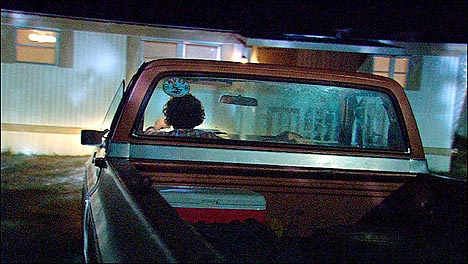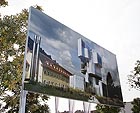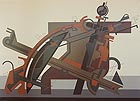
translated and summarized by: Liz Wollner-Grandville,
English summary September 28 - October 4
Kunsthalle Krems: Yearning for image. The portrait in the course of time.
In the maze of icons
As a generic term, a portrait can naturally be understood as an “image” or “reflection”. And this again leads to psychological classifications such as “character” or “personality”. All this only became possible when strategies of individualisation were introduced in modern art. And it is exactly this what makes portrait exhibits fascinating, such as the one currently shown at the Kunsthalle Krems - as long as one is prepared to deal with classic retrospective projects.
Countless art historical episodes have taught us - despite all theory - that a portrait is a construction. For example the scenario in which Denis Diderot let himself be portrayed by Anna Maria Thersbusch in 1767. In order to avoid a trivial realistic image of him, Diderot posed in the nude and gave strict, ideologically trimmed instructions, on how his body must be depicted on canvas – in the same fashion as philosophers of the ancient world. The actual theme is a result of the specific view- and production circumstances accorded through the social conventions.
The beginning of the exhibition in Krems marks this topic with a Mona Lisa painting by Gelitin, followed by an art historical tour with 180 works. Amongst the main contributors are Andy Warhol, Pablo Picasso, Alberto Giacometti, Francis Bacon and Gerhard Richter, whereby the array ranges back to Lucas Cranach or Wilhelm Busch as well as more recent works by Clegg & Guttmann, Lisa Ruyter, Julian Opie, Plamen Dejanoff, Marcin Maciejowski, Katrin Plavcak or Siggi Hofer. VALIE EXPORT, Arnulf Rainer, Cindy Sherman, Jürgen Klauke or Christian Boltanski represent some of the post-war classics. The selection stems from a co-operation with the Albertina’s Batliner Collection as well as other museums, and the collaboration with numerous galleries.
Knowledgeable visitors could easily come up with conceivable additions and regroupings, something that lies in the nature of the general theme. Nevertheless, the exhibit offers exciting contrasts, comparisons, and conclusions. When Markus Schinwald is viewed in context with Anton Romako or Elke Krystufek with Xenia Hausner, when the actionist painting strategies by VALIE EXPORT or Sarah Lucas are suddenly subsumed as “portraits”, or if works by Ines von Lamsweerde and Gabi Trinkaus and their strongly contrasting construction concepts of female images are juxtaposed, and when gender questions are raised by Jürgen Klauke’s photographs. Exactly this would have offered the opportunity to transfer the considerably too classic term of portrait into the contemporary forms of reflective media art. This could be an upcoming project of the Kunsthalle Krems, as the institution is once again in a transition phase.
By Roland Schöny
Kunsthalle Krems
3500 Krems, Franz-Zeller-Platz 3, until 26.10.09
www.kunsthalle.at
Aargauer Kunsthaus: Teresa Hubbard & Alexander Birchler – No Room to Answer
Suspense in an infinite loop
The artist duo Hubbard/Birchler started working together in the early 90’s. Currently, the Aargauer Kunsthaus is presenting the most extensive exhibit of their works ever shown. The presentation encompasses objects, photographs, and video installations created between 1990 and 2008 by the Irish-born Teresa Hubbard, in Ireland and the Swiss Alexander Birchler.
Their work mainly focuses on the creation of illusions and the, for this purpose, essential stylistic methods. These in turn accentuate the movie-like style of their photographs and the qualities of the stills in their extravagantly produced video installations. In most of their videos, the story coalesces with the structure; as for example in “Single Wide” (2002), in which the interaction between the inner- and the outside world interlock in an infinite loop with the plot: a distressed woman crashes her pick-up truck at full speed into the kitchen of a trailer home - again, and again, and again. Her hopeless situation is underlined by the loop from which there is no escape, while the camera shoots the happenings around the home, which is set up like a show-case, practically without a cut; in numerous circles from inside towards the outside, thereby moving the plot forward.
Without words, Hubbard/Birchler’s pictures are infatuating storytellers, assisted by everyday noises and music conveying emotions. Out of this play with expectations, suspense develops, which does not discharge until shortly before the climax. What remains is a feeling of ambivalence, as for example in the eight-part photo series “Falling Down” (1996): The moment, in which a book, a pillow, or money falls out of the protagonist’s hands, seems as if it were frozen. The reasons, which lead to these stills, remain hidden and mysterious. The seemingly spontaneous shots turn out to be meticulously arranged scenes, in which the falling objects were suspended with almost invisible threads outside of the image field: suspense in the real sense of the word.
With Hubbard/Birchler’s 54-minute“Grand Paris Texas” (2008) their first traditional film, including a conventional beginning and ending, is presented. The documentary focuses on “The Grand”, the ruins of a formerly prosperous movie theatre, which is now a rundown, abandoned building in the middle of the Texan town of Paris. Here, around this theatre of illusions, dreams and disillusionment collide with one another, and over and over the plot focuses on forgetting, estrangement, and emptiness – a sensitive and melancholy film illustrating the not-seeing or no-longer-being-able-to-see pictures.
By Sylvia Mutti
Aargauer Kunsthaus
5001 Aarau, Aargauerplatz, until 08.11.09
www.aargauerkunsthaus.ch
Ausstellungspavillon: Platz der Freiwilligen Schützen/Bad zur Sonne: Utopia and Monument I – On the indifference of art between privatization and the public sphere
Autumn saunter
Here they are again: works in public space within the framework of the “Steirische Herbst”. And not only one commissioned work, but 10 positions. Sabine Breitwieser’s concept, designed to last for two years, addresses the tradition of the Steirische Herbst of integrating public space (the city of Graz) into the artistic happenings, and is also devoted to the memory of the artist Hartmut Skerbisch, who passed away this year.
The manner in which the artistic objects are spread around the city remind of the sculpture projects in Münster. And among them is Andreas Siekmann’s “Trickle Down” (2007), actually shown in Münster. It goes without saying that both his installation, placed at the Landhaushof, and Dolores Zinny’s and Juan Maidagan’s “Curtain Call”, in front of the town hall on the main square, cause a major stir among the residents of Graz.
Another provocative work is David Maljkovic’s “A monument for Graz”: a banner announcing a monumental construction project. This object is displayed at the Karmeliterplatz, a location that is politically charged because it is both the seat of the conservative People’s Party (ÖVP) headquarters as well as a heatedly debated as a possible new venue for the Kunsthaus.
Ayse Erkmen visualizes how confusing signs and forms installed in public space can be, Lara Almarcegui examines brown-fields, Heather and Ivan Morison mail cards a Michael Zinganel holds a fictitious dialogue, and locations, which are not considered to be popular among the residents of Graz, like the Volksgarten (Nils Norman), and the vicinity surrounding the Bad zur Sonne are chosen as special venues. This is where one finds the pavilion for the presentatiion cooperative, which not only takes up public space, but also was adopted by Breitwieser to serve as an exhibition centre, presenting the charted history of those monuments located in public space.
By Nora Theiss
Ausstellungspavillon: Platz der Freiwilligen Schützen/Bad zur Sonne
8020 Graz, Platz der Freiwilligen Schützen, until 18.10.09
Strabag Kunstforum: Jan Vasilko – Utopia and Visions from Eastern Europe
Slovakian constructivism for the 21st century
Upon entering the Art-Lounge, the large-format acrylic painting, - which if he was still alive in the 70’s, could have been created by Kandinsky – catches ones eye. The quality of the purely constructivist work is truly impressive, and despite being painted in the style of the pioneer of abstract art, its autonomy cannot be overlooked. It is mainly the colouring, which reminds of the 70’s with its nuanced brown and ochre tones and which distinguishes itself from the classical constructivist paintings.
After having seen the entire exhibition, including some of its less spectacular paintings, one comprehends what makes these magnificent and daring works, all meticulously painted, so convincing – mainly because of their autonomy. They all seem to have originated through the usage of everyday forms and colours. Not Ivan Kliun or Kasimir Malevich gave the stimuli for the compositions, but those forms and colours, which the artist found in his own environment.
In addition to the above-mentioned large-format canvas, the designs for a museum of contemporary art in Kosice are remarkable. Here again, the form language reminds of Paul Klee and, similar to his paintings, there is no hint of spatiality. Let alone of recognizable buildings. But it is these paintings by Jan Vasilko, which remind of great peers, but originate on a completely different basis. This is the only explanation as to why such a daring endeavour of a new interpretation of constructivist art can be successful in the 21st century.
By Wolfgang Pichler
Strabag Kunstforum
1220 Vienna, Donau-City Strasse 9, until 02.10.09
www.strabag.-kunstforum.at
Mehr Texte von translated and summarized by: Liz Wollner-Grandville


 Teilen
Teilen




